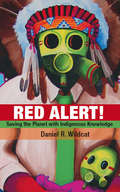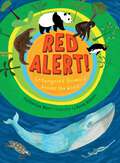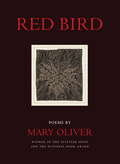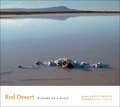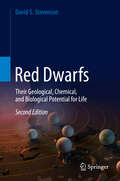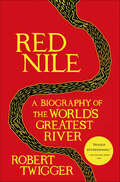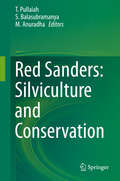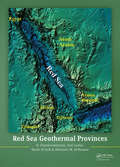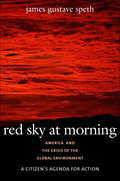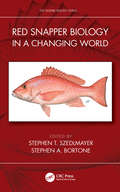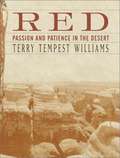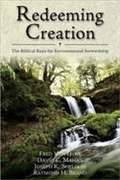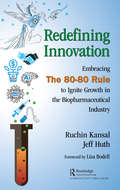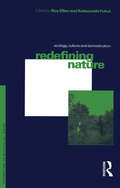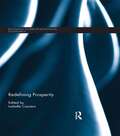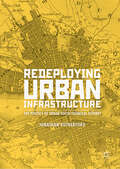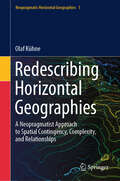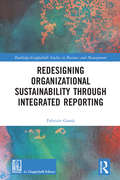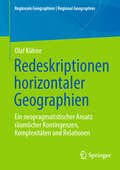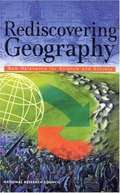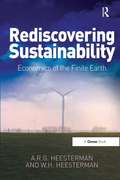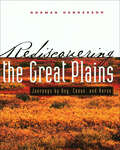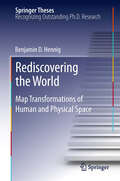- Table View
- List View
Recyclo-gami: 40 Crafts to Make your Friends GREEN with Envy!
by Laurie Goldrich WolfWhat can you make out of your old bits of paper, leftover pieces of yarn, or not-so-brand-new cartons and containers? Craft your own purse out of playing cards, whip up a scrapbook made of cereal boxes, or a dollhouse from an empty juice carton! Tweens and teens can start crafting using the easy to follow instructions and photographic directions the smart way. All crafts are made out of materials that many of us find just lying around the house or sitting on the curb waiting to be tossed in a landfill. Overpriced décor, fashion, and gifts are out, and recyclable crafts are in!
Red Alert!
by Daniel R. Wildcat"Red Alert! offers insight, hope, and a path forward."--Billy Frank Jr., Chairman, Northwest Indian Fisheries Commission"What the world needs today is a good dose of indigenous realism," says Native American scholar Daniel R. Wildcat in this thoughtful, forward-looking treatise. The Native response to the environmental crisis facing our planet, Red Alert! seeks to debunk our civilization's long-misguided perception that humankind is at odds with nature or that it exerts control over the natural world.Taking a hard look at the biggest problem that we face today--the damaging way we live on this earth--Wildcat draws upon ancient Native American wisdom and nature-centered beliefs to advocate a modern strategy to combat global warming. Inspiring and insightful, Red Alert! is a stirring call to action.Daniel R. Wildcat (Yuchi, Muscogee) is the director of the American Indian studies program and the Haskell Environmental Research Studies Center at Haskell Indian Nations University in Lawrence, Kansas. He is the co-author with Vine Deloria Jr. of Power and Place: Indian Education in America and the co-author of Destroying Dogma: Vine Deloria Jr. and His Influence on American Society.
Red Alert! Endangered Animals Around the World
by Catherine BarrAn interactive look at endangered animals imploring readers to discover fifteen species facing extinction.Inspired and endorsed by the "Red List" database of animals in peril maintained by the International Union for the Conservation of Nature (IUCN) this brightly illustrated book introduces species from six different habitats on six continents. Blending approachable text, secondary facts and lush art, Red Alert! offers full portraits of animals such as the Chinese giant salamander, the snow leopard, the blue whale, and the giant panda, and provides young activists additional resources for how they can help save these beautiful creatures.
Red Bird
by Mary OliverMary Oliver's twelfth book of poetry, Red Bird comprises sixty-one poems, the most ever in a single volume of her work. Overflowing with her keen observation of the natural world and her gratitude for its gifts, for the many people she has loved in her seventy years, as well as for her disobedient dog Percy, Red Bird is a quintessential collection of Oliver's finest lyrics.
Red Desert: History of a Place
by Martin StupichA vast expanse of rock formations, sand dunes, and sagebrush in central and southwest Wyoming, the little-known Red Desert is one of the last undeveloped landscapes in the United States, as well as one of the most endangered. It is a last refuge for many species of wildlife. Sitting atop one of North America’s largest untapped reservoirs of natural gas, the Red Desert is a magnet for energy producers who are damaging its complex and fragile ecosystem in a headlong race to open a new domestic source of energy and reap the profits. To capture and preserve what makes the Red Desert both valuable and scientifically and historically interesting, writer Annie Proulx and photographer Martin Stupich enlisted a team of scientists and scholars to join them in exploring the Red Desert through many disciplines—geology, hydrology, paleontology, ornithology, zoology, entomology, botany, climatology, anthropology, archaeology, sociology, and history. Their essays reveal many fascinating, often previously unknown facts about the Red Desert—everything from the rich pocket habitats that support an amazing diversity of life to engrossing stories of the transcontinental migrations that began in prehistory and continue today on I-80, which bisects the Red Desert. Complemented by Martin Stupich’s photo-essay, which portrays both the beauty and the devastation that characterize the region today, Red Desert bears eloquent witness to a unique landscape in its final years as a wild place.
Red Desert: History of a Place
by Martin StupichA photographic and multidisciplinary study of one of America&’s last undeveloped—and most endangered—landscapes, edited by a Pulitzer Prize–winning author.A vast expanse of rock formations, sand dunes, and sagebrush in central and southwest Wyoming, the little-known Red Desert is one of the last undeveloped landscapes in the United States, as well as one of the most endangered. It is a last refuge for many species of wildlife. Sitting atop one of North America's largest untapped reservoirs of natural gas, the Red Desert is a magnet for energy producers who are damaging its complex and fragile ecosystem in a headlong race to open a new domestic source of energy and reap the profits.To capture and preserve what makes the Red Desert both valuable and scientifically and historically interesting, writer Annie Proulx and photographer Martin Stupich enlisted a team of scientists and scholars to join them in exploring the Red Desert through many disciplines: geology, hydrology, paleontology, ornithology, zoology, entomology, botany, climatology, anthropology, archaeology, sociology, and history. Their essays reveal many fascinating, often previously unknown facts about the Red Desert—everything from the rich pocket habitats that support an amazing diversity of life to engrossing stories of the transcontinental migrations that began in prehistory and continue today on I-80—which bisects the Red Desert.Complemented by Martin Stupich&’s photo-essay, which portrays both the beauty and the devastation that characterize the region today, Red Desert bears eloquent witness to a unique landscape in its final years as a wild place.
Red Dwarfs: Their Geological, Chemical, and Biological Potential for Life (Astronomers' Universe Ser.)
by David S. StevensonThis thought-provoking book looks at the nature of red dwarf systems as potential homes for life. Realistically, what are the prospects for life on these distant worlds? Could life evolve and survive there? How do these planetary surfaces and geologies evolve? How would life on a planet orbiting a red dwarf differ from life on Earth? And what are the implications for finding further habitable worlds in our galaxy?The author provides readers with insight into the habitability of planets and how this changes as time progresses and the central star evolves. Since the previous 2013 edition Under a Crimson Sun, there has been a rise in newly discovered planets orbiting red dwarfs, accompanied by controversial areas of research that test what we think we know about these systems. This revised edition delves into the wealth of new material uncovered since that date. It explains the often conflicting results and analyses put forward and clarifies our understanding of these exciting new worlds. The chapters explore the full width of relevant scientific discovery and speculation on the potential for red dwarf planets to host life. New content includes improved atmospheric models, new understandings of the impact of stellar radiation on the atmosphere of red dwarf worlds, tidal-locking, and comparisons with terrestrial geology and climate.
Red Nile: A Biography of the World's Greatest River
by Robert TwiggerFrom religion, to language, to the stories rooted in our faith and history books, the Nile River has proven to be a constant fixture in mankind's tales. In this dazzling, idiosyncratic journey from ancient times to the Arab Spring, Red Nile navigates a meandering course through the history of the world's greatest river, exploring this unique breeding ground for creativity, power clashes, and constant change.Seasoned historical writer Robert Twigger connects the comprehensive history of the Nile with his personal experience of living in Egypt while researching the Nile's historical origins. Twigger covers the entirety of the river, charting the length of the Nile from its disputed origins through Africa on a whirlwind tour of the rulers, explorers, conquerors, generals, and novelists who painted the Nile "red." Both comprehensive and intimate, this narrative guides readers through history by way of the mighty river known across the world.The result of this meticulously researched book is an all-inclusive history of this epic river and the incredible connections throughout history. The stories of excess, love, passion, splendor, and violence are what make the Nile so engaging, even after centuries of change.
Red Sanders: Silviculture and Conservation
by T. Pullaiah S. Balasubramanya M. AnuradhaPterocarpus santalinus L.f., popularly known as Red Sanders, an endemic tree, belonging to the family Fabaceae is confined to the southern parts of Eastern Ghats. IUCN has listed this tree as endangered. The plant has superlative characteristics in its wood and has many medicinal properties. This plant has attracted the attention of both foresters and lay man because of its high valued wood which is being illegally harvested creating law and order problem. This book is a comprehensive monograph on Red Sanders and is divided into 15 chapters. The book provides information on taxonomy, morphology, distribution, wood anatomy, wood properties and uses, dye principle, phytochemistry, pharmacology, Silvicultural aspects, propagation, cultivation practices, reproductive biology, pests and diseases, biotechnology, molecular studies, conservation, trade, commerce, socioeconomic aspects of Red Sanders, and grey areas of research. The book is profusely illustrated with colour photographs and line drawings. Relevant references have been provided under each chapter. This monograph on Red Sanders with systematic representation of information and illustrations will be a desk reference and field guide to foresters, botanists, researchers, farmers, traders and environmentalists.
Red Sea Geothermal Provinces
by D. Chandrasekharam Aref Lashin Nassir Al Arifi Abdulaziz M Al-Bassam“Today, over two billion people in developing countries live without any electricity. They lead lives of misery, walking miles every day for water and firewood, just to survive. What if there was an existing, viable technology, that when developed to its highest potential could increase everyone’s standard of living, cut fossil fuel demand and the resultant pollution” said Peter Meisen, President, Global Energy Network Institute in 1997. Even though energy is available, technology was not matured enough to tap this energy in the nineties. Now, with the advancement of drilling technology, extracting heat from hot rocks has become a reality. Very soon when CO2 replaces the circulation fluid to extract heat from granites then both fossil fuel based and renewable energy sources will coexists balancing the CO2 emissions and providing energy, food and water security to the rich and the poor countries. Red Sea rift represents the youngest spreading ridges in the world with a vast amount of heat energy stored on either side. The Red Sea is surrounded by countries with a weak economy. Developing a geothermal energy based economy in countries like Eritrea, Djibouti and Ethiopia will provide food and water security to these countries while for other countries, geothermal energy will help in mitigating greenhouse gas emissions. Although geothermal energy sources are available in all the countries since the opening of the Red Sea, millions of years ago, this was not brought to the light. Oil importing countries became highly dependent on the oil rich countries to sustain their economy and growth and thus remained poor. This book unfolds the huge energy source, hydrothermal and EGS, for the benefit of the poor countries to reduce poverty and lift the socio economic status of these countries. The book deals with i) future energy demand, ii) CO2 emissions associated with fossil fuel based power plants, iii) black carbon emissions associated biomass energy source and iv) strategies to reduce CO2 emissions by using geothermal energy as energy source mix in all the countries—oil exporting and oil importing countries— around the Red Sea. The amount of energy available from hot granites in all the countries is well documented. EGS being the future energy source for mankind, this book will form the basis for future research by young scientists and academicians. Availability of fresh water is a matter of concern for all countries. The only way to satisfy the thirst of a growing population, to meet drinking water demand and food security, is to depend on seawater. A large volume of CO2 is being emitted from desalination plants supported by fossil fuel based energy sources. This book describes the advantages of using geothermal energy sources for the desalination process to meet the growing water and food demand of the countries around the Red Sea. Oil rich countries, using its geothermal resources, can now reduce food imports and become self sufficient in food production. This book gives hope for millions of children living in the underdeveloped countries around the Red Sea to satisfy their hunger and live a decent life with a continuous source of electricity, water and food available. This book ends with a note on the economic benefits of geothermal energy vs other renewables. With the signing of the GGA (Global Geothermal Alliance) by several countries during the December 2015 CoP 21 summit in Paris, policy makers and administrators will work together in implementing the necessary infrastructure and support to develop this clean energy source.
Red Sky at Morning: America and the Crisis of the Global Environment
by James Gustave SpethThis book will change the way we understand the future of our planet. It is both alarming and hopeful. James Gustave Speth, renowned as a visionary environmentalist leader, warns that in spite of all the international negotiations and agreements of the past two decades, efforts to protect Earth's environment are not succeeding. Still, he says, the challenges are not insurmountable. He offers comprehensive, viable new strategies for dealing with environmental threats around the world. The author explains why current approaches to critical global environmental problems-climate change, biodiversity loss, deterioration of marine environments, deforestation, water shortages, and others-don't work. He offers intriguing insights into why we have been able to address domestic environmental threats with some success while largely failing at the international level. Setting forth eight specific steps to a sustainable future, Speth convincingly argues that dramatically different government and citizen action are now urgent. If ever a book could be described as "essential," this is it.
Red Snapper Biology in a Changing World (CRC Marine Biology Series)
by Stephen T. Szedlmayer Stephen A. BortoneRed Snapper Lutjanus campechanus, is an important commercial and recreational fish species and there has been much interest in maintaining its status among a variety of scientific, social and economic levels. Stocks are influenced by varying environmental conditions, changing fishing effort and efficiency, anthropogenic effects, inter- and intraspecific interactions, bycatch from other fisheries, and habitat alterations. Red Snapper Biology in a Changing World explores these changing factors and their potential effects on Red Snapper in the Eastern Atlantic region including the Gulf of Mexico and Southeastern U.S. The book will provide a better understanding of Red Snapper population fluctuations that will subsequently allow for better management decisions and more informed user groups in their efforts to maintain a sustainable fishery. It explores the responses Red Snapper have made, and are making, relative to their life history attributes such as early life history and adult ecology, especially attributes associated with population distribution and abundance, movement patterns, fish health issues and management success. A compendium of many papers presented at the 147th annual meeting of the American Fisheries Society in Tampa, Florida, this volume also includes additional research completed as a result of the symposium. It will be essential reading for fisheries scientists and managers, ichthyologists, resource and environmental managers, and policymakers who are involved with coastal fisheries.
Red: Passion and Patience in the Desert
by Terry Tempest Williams"It is a simple equation," writes Terry Tempest Williams, "place + people = politics." Nowhere is this more apparent than in the American West, where millions of acres of wilderness are at stake in the redrock desert of southern Utah. "How are we to find our way toward conversation?" she asks. One story at a time. Red traces Williams's lifelong love of and commitment to the desert, as she explores what draws us to a place and keeps us there. It brings together the lyrical evocations of Coyote's Canyon and Desert Quartet with new essays of great power and originality, essays that range from a family discussion on the desert tortoise to an investigation of slowness to startling encounters with Anasazi artifacts (including a ceremonial sash made of scarlet macaw feathers). Pursuing the question of why America's redrock wilderness matters to the soul of this country, Red bridges the divide between the political and the poetic and shows how this harshest and most fragile of landscapes inspires a soulful return to "wild mercy." The preservation of wildness is not simply a political process but a spiritual one. With grace, humor, and the subtleties of her perception, Williams reminds us of what we have forgotten in the chaos of our lives and what can be reclaimed in the stillness of the desert. Red is further proof that the writings of Terry Tempest Williams possess a revelatory power and an emotional intelligence at once rare and authentic.
Redeeming Creation: The Biblical Basis for Environmental Stewardship
by Fred Vandyke; David C. Mahan; Joseph K. Sheldon; Raymond H. BrandCombining compelling stories with both biblical and scientific investigation, Redeeming Creation addresses the ecological crisis we face today. Population Explosion, Rain forests stripped bare, Destruction of animal habitat, The death of entire species, Depletion of the ozone layer, Global warming.
Redefining Innovation: Embracing the 80-80 Rule to Ignite Growth in the Biopharmaceutical Industry
by Ruchin Kansal Jeff HuthMost people marvel at the level of innovation demonstrated by the biopharmaceutical industry in bringing new products to the market – especially in the past 20 years. However, there is a crisis looming in the industry that should be a concern to all of us who take for granted the constant pace at which new treatments, and increasingly cures, have emerged from the laboratories of current sector incumbents. In the book, we examine the evolution of the biopharmaceutical industry to understand how it became what we term a "unicorn industry" with a unique, US-centered business model that has led to multiple blockbuster products (aka, unicorns) year after year. We explore how past success has created perceived barriers to innovation diversification beyond the chemical or biological-based biopharmaceutical product, and highlight the warning signs of the industry’s decline. We define a potential pathway for transforming the industry’s business model by broadening the definition, sources, and enablers of innovation beyond the traditional biopharmaceutical product. We introduce and advocate for the 80-80 Rule - "Being 80% confident that you will only be 80% right the first time should feel normal." The 80-80 Rule is a theme that emphasizes speed and willingness to embrace uncertainty and overcome internal barriers to change. It sets the standard for redefining innovation as a platform to reignite growth of the biopharmaceutical industry.
Redefining Nature: Ecology, Culture and Domestication (Explorations In Anthropology Ser.)
by Roy EllenHow can anthropology improve our understanding of the interrelationship between nature and culture?- What can anthropology contribute to practical debates which depend on particular definitions of nature, such as that concerning sustainable development?Humankind has evolved over several million years by living in and utilizing 'nature' and by assimilating it into 'culture'. Indeed, the technological and cultural advancement of the species has been widely acknowledged to rest upon human domination and control of nature. Yet, by the 1960s, the idea of culture in confrontation with nature was being challenged by science, philosophy and the environmental movement. Anthropology is increasingly concerned with such issues as they become more urgent for humankind as a whole. This important book reviews the current state of the concepts of 'nature' we use, both as scientific devices and ideological constructs, and is organised around three themes:- nature as a cultural construction;- the cultural management of the environment; and- relations between plants, animals and humans.
Redefining Prosperity (Routledge Studies in Ecological Economics)
by Isabelle CassiersSociety today faces a difficult contradiction: we know exactly how the physical limits of our planet are being reached and exactly why we cannot go on as we have before – and yet, collectively, we seem unable to reach crucial decisions for our future in a timely way. This book argues that our definition of prosperity, which we have long assimilated with the idea of material wealth, may be preventing us from imagining a future that meets essential human aspirations without straining our planet to the breaking point. In other words, redefining prosperity is a necessary and urgent task. This book is the fruit of a long debate among 15 scholars from diverse fields who worked together to bring the depth and nuance of their respective fields to questions that affect us all. The result is a rich, transdisciplinary work that illuminates the philosophical and historical origins of our current definition of prosperity; identifies the complex processes that gave rise to the problems we face today; elucidates the ways in which our contemporary environmental, social, nutritional, economic, political, and cultural crises are interconnected; and explores why a half-century of economic growth has neither increased life satisfaction in the West nor vanquished world poverty. Approaching these broad-ranging questions from the specific standpoints of their disciplines, each of the authors offers thoughts for the future, considering possible escape routes and proposing changes to the way we live, behave, and organise society and public action – changes that actually respond, in an equitable way, to our deepest aspirations. Ultimately, in laying the groundwork for a public debate on this subject, this book poses a question to its readers: what is your definition of prosperity, and what can be done to promote it?
Redeploying Urban Infrastructure: The Politics of Urban Socio-Technical Futures
by Jonathan RutherfordThis book explores urban futures in the making, as seen through the lens of urban infrastructure. The book describes how socio-technical arrangements of energy and water provision are being recast in continuing efforts towards realising ‘sustainable’ transformation of cities. It critically investigates how infrastructure comes to matter by analyzing the shifting capacities and entanglements of diverse actors with these systems, the various means they use to envision, enact and contest changes, and the wide-ranging social and political implications of emerging infrastructure transitions. Drawing on original research into urban infrastructure debates and projects in Stockholm and Paris, the author develops a novel conceptual framework for studying and acknowledging the active, vital role of infrastructure in constituting a material politics of urban transformation. Straddling the latest theoretical insights and empirical investigation of urban planning practice and socio-technical engineering of systems and flows, Redeploying Urban Infrastructure forges new, timely reflections and perspectives which will be of interest to the growing multidisciplinary community of scholars investigating infrastructure and to academics and practitioners with a concern for understanding the wider politics of urban futures.
Redescribing Horizontal Geographies: A Neopragmatist Approach to Spatial Contingency, Complexity, and Relationships (Neopragmatic Horizontal Geographies #1)
by Olaf KühneThe first book in the series provides the concept of a theoretical redefinition of 'horizontal geographies'. These denote the spatial syntheses as undertaken in various disciplines, whether as regional studies, area studies, new regional geography, and many more. The basis of the redescription is philosophical neopragmatism, which has occasionally been taken up in the spatial sciences, but has never been differentiated into a theory-driven empirical research program. This development of the research program guides the present book. Philosophical neopragmatism, especially as conceptualized by Richard Rorty, focuses in particular on contingency of society, self, and language, which also allows spatial syntheses to be understood not as 'images of reality' but as contingent proposals for redescribing spaces. As a result of the complexity of spatial processes, their horizontal geographic study requires a triangulation of theories, methods, researcher perspectives, data, and the involvement of people without expert special knowledge. To highlight the contingency of the spatial syntheses, the presentation of the results - —here especially graphic and cartographic - —resorts to the attitude of irony. Regarding the six levels of trigangulation, neopragmatism acts as a meta-theoretical orientation framework. Against the background of the complexity of spatial developments on the one hand and to operationalize Rorty's principle of private self-creation and public solidarity on the other hand, Ralf Dahrendorf's concept of life chances is drawn upon. Especially in the differentiation of this concept made in this book, it serves on the one hand for an understanding access of the (also spatial) expression of options and ligatures,, and on the other hand it offers a normative framework for the evaluation of socio-spatial developments. The reference to neopragmatic studies on spatial syntheses conducted to date and evaluated in this book shows the potential of the approach elaborated here in conceptual detail for the first time.
Redesigning Organizational Sustainability Through Integrated Reporting (Routledge-Giappichelli Studies in Business and Management)
by Fabrizio GranàThis book explores the role of accounting and reporting practices, such as corporate and integrated reports, as organizations attempt to represent sustainability. By relying upon the case of a large international oil and gas company and its recent development of integrated reporting, this book argues that the ambiguity of sustainability as a concept, and the impossibility to fully capture it through accounting and reporting practices, does not mean that any attempt to represent it inevitably leads to distortion or obfuscates ‘reality’. Rather, the way in which this concept is presented through accounting and reporting practices can have a constructive effect on the organization through the aspirations that these representations entail. The book demonstrates that accounting and reporting practices, such as integrated reporting, are not expected to offer complete representations of organizations’ sustainability. Rather, these practices offer a number of representations (e.g. graphs, diagrams, tables, grid) that affect the way in which organizations understand and report on sustainability, changing its meaning over time. Finally, this study demonstrates that undefined concepts, such as ‘sustainability’, and practices, such as ‘integrated reporting’, mutually construct each other. The attempt to represent sustainability within the organization and the debates that this process generates, make accounting and reporting practices unfold themselves, and evolve. The book will be of interest to scholars in the field of accounting, management and sustainability, as well as practitioners from a wide array of additional fields, such as planning and control, organizations’ strategy, business ethics, corporate social responsibility and corporate reporting.
Redeskriptionen horizontaler Geographien: Ein neopragmatistischer Ansatz räumlicher Kontingenzen, Komplexitäten und Relationen (Regionale Geographien | Regional Geographies)
by Olaf KühneRäumlichen Synthesen (Landeskunden, Regionalen Geographien etc.), hier als ‚horizontale Geographien‘ bezeichnet, haben in den vergangenen Jahrzehnten eine sehr ambivalente Entwicklung genommen: Auf der einen Seite ist die Nachfrage in der Öffentlichkeit, aber auch in der Wissenschaft, hoch, auf der anderen Seite wurden ihr – im Vergleich zu geographischen Spezialdisziplinen – theoretische Defizite attestiert. Grundlage der hier vorgenommenen Redeskription ist der philosophische Neopragmatismus, der nie zu einem theoriegeleiteten empirischen raumwissenschaftlichen Forschungsprogramm ausdifferenziert wurde. Der philosophische Neopragmatismus, insbesondere in der Konzeption von Richard Rorty, fokussiert insbesondere auf Kontingenz von Gesellschaft, Selbst und Sprache. Somit werden auch ‚horizontale Geographien‘ als kontingente Vorschläge für eine Neubeschreibung von Räumen verstanden. Diese basieren auf der gerechtfertigten Triangulation von Theorien, Methoden, Quellen, Forschendenperspektiven, Perspektiven von Lai~innen und (ironischen) Darstellungsformen. Hinsichtlich der Triangulationsebenen fungiert der Neopragmatismus als meta-theoretischer Orientierungsrahmen. Vor dem Hintergrund der Komplexität räumlicher Entwicklungen einerseits und zur Operationalisierung des Rortyschen Prinzips der privaten Selbsterschaffung und der öffentlichen Solidarität wird auf das Lebenschancenkonzept von Ralf Dahrendorf zurückgegriffen. Dieses wird in diesem Buch sowohl hinsichtlich der Optionen als auch der Ligaturen weiter differenziert. Damit trägt dieses Buch zur Beseitigung des vielfach attestierten Theoriedefizits bei.
Rediscovering Geography: New Relevance for Science and Society
by Rediscovering Geography CommitteeAs political, economic, and environmental issues increasingly spread across the globe, the science of geography is being rediscovered by scientists, policymakers, and educators alike. Geography has been made a core subject in U.S. schools, and scientists from a variety of disciplines are using analytical tools originally developed by geographers.Rediscovering Geography presents a broad overview of geography's renewed importance in a changing world. Through discussions and highlighted case studies, this book illustrates geography's impact on international trade, environmental change, population growth, information infrastructure, the condition of cities, the spread of AIDS, and much more.The committee examines some of the more significant tools for data collection, storage, analysis, and display, with examples of major contributions made by geographers.Rediscovering Geography provides a blueprint for the future of the discipline, recommending how to strengthen its intellectual and institutional foundation and meet the demand for geographic expertise among professionals and the public.
Rediscovering Sustainability: Economics of the Finite Earth
by A.R.G. HeestermanDrawing on historical and current data, this thought-provoking book summarises the pathways to the present predicament and maps out strategies to develop financial and economic systems for a sustainable world. The content is arranged in three parts addressing 'Stylised Market Equilibrium', 'The Real Market Economy', and 'Present Affluence Versus the Future'. In Rediscovering Sustainability the authors help bridge the gap in understanding between scientists and the green movement on the one side and many economists on the other. Greens worry about catastrophic climate change and anthropocene mass extinction. Economists express reservations about spending substantial amounts of money on preventing environmental degradation. Aart and Wiebina Heesterman argue that there are inherent limitations in standard economics which cause blind spots in its environmental economics sub-field, as well as issues to do with simple lack of knowledge. In this timely book, the limitations of the neoclassical economics framework are examined. The authors explore the relationship between Keynesian aggregate economics and financial sustainability, as well as that between scale economies, locational economics and the understated cost of fuel for transport. The impact of economic theory on practice is examined. Conventional economic theory and political compromise bear unhelpfully on an energy market constrained by emissions targets. Rediscovering Sustainability is an invaluable aid to understanding for those teaching, studying, campaigning, policy-making, or involved with the science or politics of environmental and sustainability issues. It is also a book for those concerned with the application of economic theory in any context.
Rediscovering the Great Plains: Journeys by Dog, Canoe, and Horse (Creating the North American Landscape)
by Norman Scott HendersonEngaging travel memoir recounts author's adventures traveling in Canada's Qu'Appelle River Valley via horse, canoe, and Native American dogsled.The North American Plains are one of the world's great landscapes—perhaps the signature landscape of the continent. Today, the most intimate experience most of us have of the great grasslands is from behind the window of a car or train. It was not always so. In the earliest days, Plains Indians traveled on foot across the vastness, with only the fierce, wolflike Plains dogs as companions. Later, with the arrival of the Europeans, horses and canoes appeared on the Plains. In Rediscovering the Great Plains, Norman Henderson, a leading scholar of the world's great temperate grasslands, revives these traditional modes of travel, journeying along 200 miles of Canada's Qu'Appelle River valley by dog and travois (the wooden rack pulled by dogs and horses used by Native Americans to transport goods), then by canoe, and finally by horse and travois.Henderson interweaves his own adventures with the exploits of earlier Plains travelers, like Lewis and Clark, Francisco Coronado, La Vérendrye, and Alexander Henry. Lesser-known experiences of the fur traders and others who struggled to cross this strange and forbidding landscape also illuminate the story, while Henderson's often humorous description of his attempts to find and train old Plains breeds of dogs and horses highlight the difficulties involved in recreating archaic travel methods. He also draws on the history of the world's other great temperate grasslands: the South American pampas and the Eurasian steppes. Recalling the work of Ian Frazier and Jonathan Raban, Henderson's captivating account of his three journeys of exploration will foster a better appreciation for, and deeper understanding of, the natural and human history of the North American Plains.
Rediscovering the World
by Benjamin Hennig'We need new maps' is the central claim made in this book. In a world increasingly influenced by human action and interaction, we still rely heavily on mapping techniques that were invented to discover unknown places and explore our physical environment. Although the traditional concept of a map is currently being revived in digital environments, the underlying mapping approaches are not capable of making the complexity of human-environment relationships fully comprehensible. Starting from how people can be put on the map in new ways, this book outlines the development of a novel technique that stretches a map according to quantitative data, such as population. The new maps are called gridded cartograms as the method is based on a grid onto which a density-equalising cartogram technique is applied. The underlying grid ensures the preservation of an accurate geographic reference to the real world. It allows the gridded cartograms to be used as basemaps onto which other information can be mapped. This applies to any geographic information from the human and physical environment. As demonstrated through the examples presented in this book, the new maps are not limited to showing population as a defining element for the transformation, but can show any quantitative geospatial data, such as wealth, rainfall, or even the environmental conditions of the oceans. The new maps also work at various scales, from a global perspective down to the scale of urban environments. The gridded cartogram technique is proposed as a new global and local map projection that is a viable and versatile alternative to other conventional map projections. The maps based on this technique open up a wide range of potential new applications to rediscover the diverse geographies of the world. They have the potential to allow us to gain new perspectives through detailed cartographic depictions.

